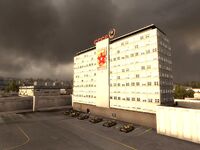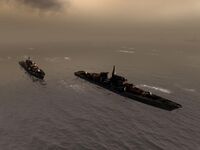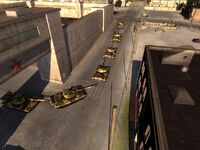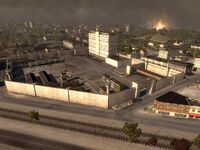The Soviet Union (full name Union of Soviet Socialist Republics) is one of the three main factions in World in Conflict and considered the main antagonist of the game. The Soviet Union was formed on December 30, 1922, and its power would rise to prominence into the late 1980s. The main power in the Soviet Union is Russia, with the other members contributing to its power. The Soviet Union is composed of fifteen republics, utilizing their resources to construct its large military.
Pre-World War III
The Soviet Union played a key role in bringing Nazi Germany down during World War II. The Soviets spearheaded the attack on Berlin, and successfully brought down the Wehrmacht. However, the Soviet Union lost millions of soldiers and citizens in its conquest to rides. Postwar Germany was divided into two states: West Germany and East Germany. The West, controlled by the United States, Great Britain, and France, would remain democratic, while the Soviet-controlled East was purely communist. Right after that, it was suspected that the Soviet Union desired to spread its communist influence over Western Europe. Aware of this, the United States and its European allies formed NATO, a multilateral alliance aimed at repelling the Soviet influence over the West.
In response to this, in the following years, the U.S.S.R., under the rule of dictator Josef Stalin, assumed control of most of Eastern Europe and formed the Warsaw Pact, a pro-Soviet alliance. The Soviet Union also pursued a nuclear arms race with the United States. This led to the Cold War, in which the Soviet Union repeatedly tried to overpower its American opponent. In spite of their vast sphere of influence, the Soviets suffered from a severe lack of natural resources. The country was in a state of financial collapse, and desperately needed to regenerate the lost resources rapidly. Although they lacked resources at that time, the Soviets managed to keep up with the Western superpower, the United States for nearly 50 years. These problems led to the Soviets collapse historically, and in this alternate time led to them devising a desperate plan.
Prelude to World War III
The Soviet Union's power, as well as its economy, was at the breaking point. The Politburo held an emergency meeting at the Kremlin, and decided that there was only a few choices left to remain in power. Initial plans were to blackmail the Western European countries to provide them economic aid, but the negotiations failed in totality it appeared. The Soviet Union took immediate action. Rather than see the motherland fall, alongside their reputations, careers, and more, the Soviet Union leadership pursued a course of war to remain in power. World War III begins.
World War III – European Theater
Preparations
European Theater - Norway - Norwegian Coastline
The Soviet Union started its covert operations in Western Europe. The Soviet Union prepared a rapid offensive against NATO forces in Norway. The plan was to use Ekranoplans to infiltrate the Norwegian Coast and disable Anti-Aircraft Batteries to allow its strategic bombers safe passage into the European Front, as well as to regain its initiative on the European Theater if NATO ever gained ground superiority. The attack was a success, and the NATO forces there were unable to report for reinforcements due to the rapid assault. The Commander-in-Chief of the forces in Norway reported back to the CINC-West Germany Forces and gave them a green light to initiate their operations.
Soviet Assault
European Theater - West Germany - Berlin - Brandenburg Gate, The Berlin Wall
The Soviet Union made its next move by assaulting many Western European countries, namely France, West Germany, and other countries that made up the organization known as NATO.
The Soviet Forces in West Germany (SFWG) were ready for the assault on the Berlin Wall. They were already prepared by dawn, and waiting for one more thing before starting. A group of Spetsnaz Commandos were sent to infiltrate a NATO base there, as well as AA Fortifications. Things went out as planned and the SFWG began the assault headed by Colonel Orlovsky, Lieutenant Romanov, Captain Malashenko, and Major Lebedjev, the four top Soviet Army officers. The NATO forces were never equipped to hold West Berlin, and the garrison was defeated before noon. Overwhelming numbers of Soviet tanks and troops breached the Berlin Wall and eliminated the NATO presence there. Denmark was besieged as the Soviets came in from West Germany, and they sent forces to invade the rest of Scandinavia. The non-aligned communist country of Yugoslavia was quickly captured by Soviet forces, violating the nation's neutrality, securing the vast majority of Eastern Europe. Most NATO forces were focused on defending Western Europe.
European Theater - France
After the capture the border of West/East Germany, the Soviets proceeded to invade parts of eastern France, and southern France. The Soviet Navy somehow destroying, or crippling the U.S. Sixth Battle Fleet in the Mediterranean Sea, and then launched their invasion of France. Initial resistance was small, and the Soviets were able to secure much of the French southern coast. The occupation of France took longer than expected, and NATO forces struggled to defend France at first.
U.S. Intervention
European Theater - France
After initial operations in France, NATO then began pulling in troops from the United States of America, one of the founders of the alliance. The United States sent most of its active duty forces into the European Theater, while presumably began mobilization of its general populace, and beefing up the National Guard. While the U.S. mobilized the majority of its forces for service in Western Europe, the initial US expedition, with French NATO forces, made significant gains. They were able to drive the Soviets out of France, absolutely destroying the Southern Soviet incursion and retaking more and more parts of West Germany. Despite this, the Soviets were still holding in parts of West Germany.
Aftermath
The Soviets still control parts of Europe, most notably parts of West Germany. Soviet Operations in the European Theater continue, and the ultimate destination of U.S. Forces was called into question when the continental US was threatened. The fate of Western Europe continues to hang in the balance.
World War III – Soviet Theater
U.S. Operations on Soviet Soil
Soviet Theater - Somewhere near Murmansk - Soviet Power Plant
A battalion of US troops infiltrated a location close to a power plant to secure documents from a downed US stealth bomber, which had been scouting in deep Russian territory. The Soviet Forces had a hard time fighting the threat back. The Soviets seemed unable to drive back the U.S. Forces, likely due to the lack of skilled officers and soldiers in the area, compounded by lack of heavy equipment and first rate soldiers, all of which would be devoted to the West European front. The Soviets totally failed in all strategic and tactical objectives, with the NATO forces escaping with little damage. This would serve to lead to the next battle.
Soviet Theater - Kola Peninsula - Soviet Submarine Base
The Soviets were unable to alert their submarine base in Severomorsk and were caught by surprise. The Soviets had enough time to evacuate a few of their nuclear-powered submarines, but the rest were destroyed during the assault. The Soviet Forces finally drove the U.S. Forces out of the area, but still failed to protect their submarine fleet, as a majority of their submarine fleet was destroyed.
Soviet Theater - Northern Russia - Quarry
The Soviets had commandeered a quarry and converted it into a prison camp for NATO officers. Colonel Orlevsky lead the defense, with Lieutenant Romanov being the defensive reserve. Captain Malashenko audibly complained about the lack of reliable intelligence given to them by KGB GRU, with their estimates of enemy strength dramatically underestimating the enemy, and the final estimation was that a divisional sized force had attacked them. The battle ended in favor of the Soviets, with NATO taking significant losses.
World War III – American Theater
Preparations
The US Operations in the European Theater threatened the Soviet Initiative. The only way to gain ground and air superiority in Europe was to drive the American Forces back to their mainland. And to do that, they needed to invade America itself. Most of the United States Armed Forces were in the European Theater at that time, leaving America seemingly open to attack.
The initial strike was against the few remaining US Fleets guarding the US East Coast. The submarines that remained after the raid on Kola Peninsula led the attack on the US naval bases in Norfolk and Little Creek, but the US forces were alerted beforehand and managed to push the Soviets back, leading to another Soviet attack, this time on New York City.
American Theater - New York City - Liberty Island
Having failed to raid the U.S. Naval Yard Little Creek, the Soviets sent a force of Spetsnaz commandos to infiltrate Liberty Island, Governors Island, and Ellis Island. The US proved difficult to defeat, and soon found Ellis Island liberated. To give them more time, they planned to detonate a chemical bomb in the Statue of Liberty, but ultimately failed. The Spetsnaz forces were wiped out from the Islands, likely with no prisoners taken after the attack, but brought along with them millions of dollars in US equipment and vehicles, indirectly damaging the remaining US forces and the New York National guard. The political ramifications of the threatened use of chemical weapons on a civilian population center are unknown, but can be estimated to be severe after the war.
Soviet Invasion of Seattle
Following their failure to attack New York City, the Soviets decided upon a grander plan, upon seeing the initial success, and planned an offensive against America and planned a surprise invasion against the West Coast. This time, the city of Seattle in the state of Washington became the target.
American Theater - Washington - Seattle - Seattle Docks
The Soviet's plan was to force a beach head at Seattle through the use of civilian freighters, a huge gamble, but one that would succeed. The U.S. Coast Guard tried to contact the freighters with no avail, and soon, the Soviets began their operations before the Harbor Control could even conjure a response. Soviet helicopters rose into the air and fired upon the Seattle Police Department, forcing them to retreat from the docks. On the police force's retreat, the Soviets unloaded their forces into the city.
After securing the docks, the officers landed and gave orders to secure the city and drive out the U.S. Forces. Resistance was surmountable, as the Washington National Guard were wholly unprepared for the assault and were swiftly removed from the city, and the few remaining encircled troops left were overwhelmed by the assault. The resulting attack destroyed much of the city's infrastructure, including the Kingdome. The attack was a success, giving the Soviets a promising beachhead in North America.
American Theater - Washington - Seattle - I-90 Bridge
As the invasion of Seattle continued, the Soviets proceeded to eliminate any hostile presence in the areas and attempt to round up civilians, presumably to keep them out of the combat zones. The Soviets spotted the U.S. Troops crossing the I-90 bridge, an important bridge that was the only one to cross the inner harbor, and proceeded to attack. The Soviets were able to inflict significant damage on Cpt. Bannon's force, but could not stop the U.S. retreat from evacuating thousands of civilians, hundreds of soldiers, and detonating the bridge. This was their first significant tactical failure: Losing dozens of vehicles to the US Air Force and Artillery, the loss of infrastructure scuttled by the US forces, and the loss of a valuable amphibious assault force and Paratroopers sent to make a foot hold across the bridge. It is likely they lost at least a brigade sized force trying to take and hold the bridge.
In the end, they were forced to redirect their offensive when the Americans destroyed the I-90 Bridge, cutting them off from the south eastern suburbs. However, the Soviets didn't delay in moving around on the land bridges and to take more territory.
Soviet Operations in the American Theater
American Theater - A few miles from Seattle, Washington - Countryside
The Soviet Forces advanced in two groups: One group followed the retreating Americans, while the other secured Seattle for the arriving reinforcements.
The Soviet Forces that were trying to take more ground found their first guerrilla resistance. After fighting them off, a Soviet scout force reported a counter-attack by the regular army. The Soviet commanders, undeterred, stayed and fought off the attack, gaining control over part of the countryside.
American Theater - Coast of America - Pine Valley
The pursuing Soviets sent a force of paratroopers to secure Pine Valley, a small town close to Seattle. The paratroopers spotted the U.S. troops, but the Americans were ready for them and quickly dispatched them.
After hearing this, the main Soviet Forces double timed it to drive the Americans out and keep up their operational momentum. While the battle was close, the Soviets failed to take over the town as a US naval vessel arrived to provide danger close artillery support, destroying the soviet spearhead and halting their advance.
American Theater - A few miles from Seattle, Washington - Countryside
After fighting off the counter-attack, the Soviets retreated to Seattle where they reinforced and reorganized to advance once again. The Soviet forces in America heard the news about the battle of Pine Valley, and that the U.S. Forces successfully defended the area. The now regrouping U.S. Forces were considered one of the top priorities.
Colonel Orlevsky, leading the anti-partisan forces, was tasked with capturing the partisan leader and army officers he was meeting nearby. National guard and Army forces tried to counter attack, but without their commanders at the helm, they were ultimately pushed back.
American Theater - Cascade Range - Cascade Falls
After failing to secure Pine Valley, the Soviets redirected their attention northeast, towards the Cascade Range. Their objective was to capture Fort Teller, where the Strategic Defense Initiative (or "Star Wars" as the public called it) was located. Unfortunately, project itself was a scam, and if the Soviets found that out, they could be able to use Nuclear Weapons against the US and her allies.
The Soviet advanced towards Fort Teller lead them to a town called Cascade Falls, not far from Fort Teller itself, where a battle was about to take place. While the Americans were able to secure the town's bridges before the Soviets got there, the superior Soviet Forces were able to wipe out those defenses, along with a number of tanks, infantry, and choppers. The battle was now shifting into the middle of town, where the US Forces were suffering heavy casualties from Soviet Forces.
The Americans took time to devise a plan, and it worked out. The Soviets in the middle of town were hit by a carpet bomber, but the majority of the forces were still to come. The majority of the elite Soviet Forces headed by Colonel Orlovsky were on their way. The Soviets present in that area tried to provide a foothold for the arriving forces, and they succeeded. Seeing only one viable option left, the Soviets didn't expect US Forces to launch a nuke. But the Soviets didn't give up that easily, and before getting hit by the nuke, destroyed a platoon of US Tanks.
In the aftermath of the battle, the Soviets proceeded to return to Seattle. Two officers had different opinions on the matter. While Captain Malashenko wanted to fight in Seattle once more, Colonel Orlovsky wanted to return to the European Theater and save his weakening Forces. Captain Malashenko shot Colonel Orlovsky dead for what he saw as betrayal. While Malashenko headed of to Seattle, Major Lebedjev decided to go on with Orlovsky's plan.
American Theater - Highway to the US Coast
The remaining elite forces headed by Lieutenant Romanov and Major Lebedjev proceeded to retreat. They planned to smash right through a heavily fortified US base and then deal with a large US regular army group persuing them. The first part of their plan went well, as they were able to capture the base, and annihilate most of the US forces guarding it, albeit with the loss of a few tanks.
Lt. Romanov and Major Lebedjev then ordered their forces to dig in around the base, and wait to confront the American regular army units pursuing them. The pursuing US forces consisted of nearly a battalion, however, they managed to hold off the American attack for a short time, allowing the rest of the convoy escape and destroying several American tanks and helicopters before Major Lebedjev called in TU-95 bombers to carpet bomb the high way, utterly destroying the base.
American Theater - Clearwater Creek
The Soviet Forces in Clearwater Creek was only small, and the US Army proceeded to reclaim it. The Soviets, while lacking superior forces, made a stand. But clearly that wasn't enough. The forces there were soon overwhelmed by the Americans.
American Theater - Seattle - Washington

The Soviet HQ in the American Theater.
The Soviet occupiers in Seattle were starting to lose their grip on the city, and soon got caught off-balance. The US Forces would soon make an offensive front. The Soviets and US Forces there were almost a match for each other, and both suffered heavy casualties. None of Webb's initial forces survived.

The two Soviet destroyers at the Seattle Docks.
The Soviets had two destroyers in the vicinity of the area. Soviet Forces called on their support, and responded by destroying a platoon of US tanks and IFVs. But the US Forces sank them using artillery and air support.

Soviet 34th Guards Tank Division.
The Soviets activated their tank units from the Main HQ to attack US forces trying to control the docks, leaving the base undefended. The Americans were able to secure the docks and the main HQ. After that, the US Forces destroyed all the Soviet freighters. However, once the battle was over, Webb was shot by a sniper who was originally aiming for Col. Sawyer.

The Base is protected by concrete walls reinforced by anti-tank infantry.
Seeing victory, the Americans were also caught off-guard by Captain Malashenko's forces. Malashenko was able to destroy almost half of the US Forces there, until he saw them retreating to make a final stand. Captain Malashenko and the remaining Soviet forces were soon attacked by a US flanking force, and Malashenko was presumably killed in battle. Seattle was reclaimed by the US forces.
Aftermath
The Soviet Forces were driven out of the American Theater, and the Americans reclaimed all their lost land.
The Future of the Soviet invasion
Even though the Soviets were driven out of the American Theater, operations still continue in the European Theater. What happens next is unknown, but there are four possibilities:
- The Soviets might seek revenge for driving them off the American Theater, and might make a larger invasion on the United States. Extremely unlikely since the soviet attempt relied upon absolute surprise to evade US pacific patrols, and now that US forces are aware of the possibility would strike against soviet naval infrastructure along the Pacific coast to prevent another such invasion and destroy the Trans-Siberian railroads to stop any troops from being moved over.
- The Soviets take significant time to recover from the losses in the American Theater, and the Americans delay trying to reclaim Europe due to the large number of Soviet forces there. Morale among Soviet soldiers who learn of the operation would likely plummet as slowly, more and more technologically equipped, and better trained NATO soldiers are thrown against them with partisan activity in West Germany disrupting supply and troop movements. Combined with latent Warsaw pact Nations discontent with their communist governments, and it may herald the beginning of a general revolt across the entirety of Eastern Europe now that he bulk of all pacifying forces are redeployed, or already deployed on the front lines.
- The Soviets retreat from the European Theater and initiate peace talks, this is the most likely outcome. In a strategically untenable situation, having just lost a large number of elite amphibious assault troops and general forces, and on the verge of economic collapse having already engaged stringent rationing to the civilian population who has been facing economic strangulation in the upcoming years, their would either be a revolt, or a general military coup, possibly spearheaded by Lebedjev and like minded officers. Even with the new support from China, the alliance would quickly fall apart due to the failed invasion resulting in possibly hundreds of thousands of dead Chinese soldiers who were ambushed in the Seattle Bay area by US Air, artillery, and Naval forces, and previous historical grievances.
- Finally, the most likely depending on the fanaticism of Soviet leadership, the loss of so many elite forces in the Seattle operation, combined with their already crumbling economic state which was their purpose for entering the war in the first place, the Soviet forces have seen the peak of their success and will slowly be driven back as NATO strategic bombing and strike forces destroy more and more Soviet Infrastructure. Very quickly, the soviet Public would no longer tolerate a war. Historically by this time, Soviet conscription methods were becoming increasingly difficult to enforce. Followed by a disastrous war, and famine looking, the Soviet Leadership would have no choice but to surrender.
Base of Operations
- European Theater: West Germany
- American Theater: Seattle, Washington (formerly)
- Soviet Theater: Moscow, Russian SFSR
Soviet Military Doctrine
The Soviet Military Doctrine is centered around the focus of superior firepower. The main conventional weapon of the Soviet Union is the Tank, which makes up a bulk of the Ground Forces. The Soviets tend to form a spearhead of tanks intended to wipe out the main line of resistance. Soviet Doctrine also calls for the synchronization between the Soviet Air Force and The Soviet Ground Forces, which leads to something similar to the WWII German Blitzkrieg.
Another important concept in the Soviet doctrine is the Operational Maneuver Group, which aimed at breaking the enemy's defensive line or offensive attack, and sending in several divisions to exploit the breakthrough.
Advancements in technology
The Soviets, even though they cannot reproduce most US advanced equipment, are able to keep up with the global superpowers. Soviet equipment lacks the advanced technology used by the West, but makes up for in raw-firepower and versatility as well as in large numbers.
Soviet Firepower is embedded within units like the T-80U, Mi-24V, and the 2S7 Pion. All Soviet units are capable of matching up against their US Counterparts, proving to be deadly in combat. Old units such as the T-62A, are so reliable that they can even match up with the US M60 Patton.
Soviet Strength of the Military Branches
Soviet Army / Ground Forces:
- Armed Personnel - 2.8 million
- Armored Fighting Vehicles
- Tanks: 4,436 Active, 1,234 in reserve
- IFVs / APCs: 5,456 Active, 2,000 in reserve
Soviet Air Force:
- Aircraft
- Combat / Transport Choppers: 3,400 Active, Unknown in reserve
- Fixed wing Aircraft: More than 2,000 in Active service
Soviet Navy:
- Fleets: 4 / 2 Submarine Fleets
- Mainland Fleet
- Pacific Fleet
- Barents Sea Fleet
- Atlantic Fleet
Submarine Fleets are not listed since they shift their locations on a regular basis.
